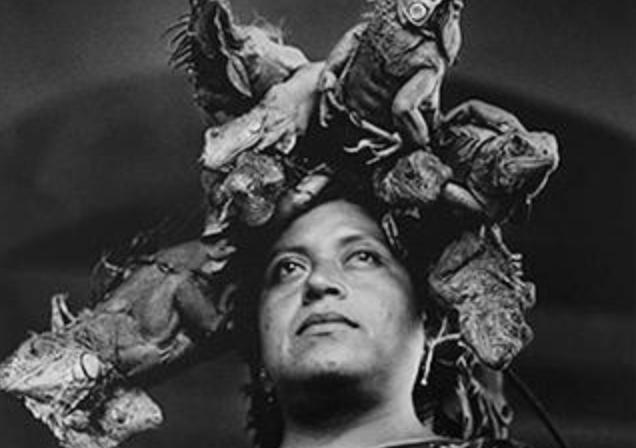
Nuestra señora de las iguanas (Our Lady of the Iguanas) (1979) by Graciela Itrubide, gelatin silver print, printed 1990s. 15 1/8 x 12 7/8 in. Signed in ink in the margin.
The Academy Art Museum of Easton recently has added Graciela Iturbide’s “Our Lady of the Iguanas” (1979) to its growing permanent collection of black and white photographs. Hispanic artist, Iturbide (b. 1942, Mexico City) has achieved an international reputation for her photographs of the indigenous people of Mexico. “Our Lady of the Iguanas” is one of a series of photographs Iturbide took from 1979 to 1986, when she was invited to visit Juchita, a small town on the coast Mexico in the valley of Oaxaca, to photograph the Zapotec people. The Zapotec, known as the “inhabitant of the clouds,” are descendants of an ancient matriarchal society that existed from 500 BCE until 900 CE. Juchitan women run a successful economy based on their ability to trade. The people describe themselves as well nourished, happy, wealthy enough.
“Our Lady of the Iguanas” fulfills the artistic parameters Iturbide set for herself: “I need to be close to the people…I need their complicity…Complicity, for me, is looking at someone and discovering that they are looking back. If I don’t get that answering look, I don’t get results.” The photograph shows Zobeida Dias who came to the market to sell the iguanas she carried on her head in the traditional manner. Iturbide describes the moment: “Here she comes with the iguanas on her head! I could not believe it. She put the iguanas on the ground and I said: ‘One moment, please. One moment! Please put the iguanas back’.”
“Only one photo from the 12 I took of her was good, because it was the only one where the iguanas raised their heads as if they were posing.” She notes that she had only 12 frames left on her film, but she managed to capture what she was looking for, that “ethereal sense of self-possession.” Zobeida is a woman of majesty and mystery. Shot from below, the figure rises prominently above the viewer’s eye level, creating a dramatic pose.
“Our Lady of the Iguanas” was a great success with the citizens of Juchitan, who requested copies of the photograph to display in their houses. Postcards were made to sell at the market. They named the work “The Juchitan Medusa,” after the Greek gorgon Medusa, who angered Athena and was transformed into a monster with snakes for hair. If someone looked at Medusa they immediately turned to stone. However, once Medusa was killed and the snakes severed from her head, their blood became a cure that saved lives. An important food source to the citizens of Juchitan, iguanas also are involved in many of their myths. Therefore, “The Juchican Medusa” is viewed as a positive image.
Iturbide named the photograph “Our Lady of the Iguanas” and described the iguanas as forming a halo. Her interpretation recognizes the prevalence of images of the Madonna and Saints on the streets and in their homes and churches. The photograph has become one of the quintessential Iturbide images. When journalist asked Zobedia if she was a feminist, she answered, “Yes. When my husband died, I work, I take care of myself.” Something of a celebrity. Zobedia died in 2004.
Iturbide describes herself as feminist: “I am feminist. And as I am, in my photographs, my way of being is revealed. That does not mean that I deliberately do feminist photography. I do what surprises me. Something is beautiful when it touches my heart. My eyes see them, and my heart shoots them.” Iturbide’s photographs find and celebrate the essence of the image, whether it is from her Mexican heritage or from her photographs in Cuba, Germany, India, Madagascar, Hungary, France, and the United States. “Photography for me is a ritual. To go out with the camera, to observe, to photograph the most mythological aspects of people, then to go into the darkness, to develop, to select the most symbolic images. The photographer’s job is to synthesize, to make strong and poetic work from daily life.”
The Academy Art Museum’s goal is to diversify its permanent collection of traditional black and white images created be many well-known American photographers. Iturbide’s is the first Latin-American woman’s photograph represented. The acquisition on “Our Lady of the Iguanas” acknowledges Iturbide’s technical proficiency and her remarkable ability to capture a compelling and authentic human presence.
NOTE: To learn more about the matriarchal society of Zapotec please go here.
Iturbide’s fascination with the camera was enhanced when she met Henri Cartier-Brisson in Europe and adapted his declarative statement to find the “decisive moment.” To wait, and watch and find that one spontaneous moment that is the essence of the subject.
1920s Diego Rivera, Frida Kahlo, Sergei Eisenstein, Langston Hughes, Henri-Cartier Brissom, Tina Modotti, Edward Weston has no works by Latin American women artists in the Permanent Collection, and the addition of Iturbide’s print would help diversify the Museum’s photographic holdings considerably traditional black and white darkroom prints in our Collection by master American photographers, educational encounters and create dialogues.
Beverly Hall Smith was a professor of art history for 40 years. Since retiring with her husband Kurt to Chestertown six years ago, she has taught art history classes at WC-ALL and Chesapeake College’s Institute for Adult Learning. She is also an artist whose work is sometimes in exhibitions at Chestertown RiverArts and she paints sets for the Garfield Center for the Arts.



Write a Letter to the Editor on this Article
We encourage readers to offer their point of view on this article by submitting the following form. Editing is sometimes necessary and is done at the discretion of the editorial staff.